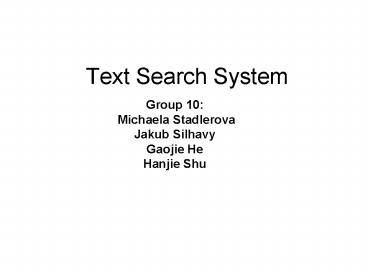Text Search System PowerPoint PPT Presentation
Title: Text Search System
1
Text Search System
- Group 10
- Michaela Stadlerova
- Jakub Silhavy
- Gaojie He
- Hanjie Shu
2
Outline
- 1.System Architecture
- 2.Components
- 3.Demonstration
- 4.Evaluation
3
System Architecture
4
Components
5
Main Components
- Query Processing
- Document Processing
- Document Index
- Search Rank
- Clustering
6
Query and Document Processing
- Tokenization
- Stemming
- Removal of Stop Words
7
Document Index
- Step one Vector Generation
- Document document id, document name, maximum
term frequency, existed term and its frequency. - Step two Inverted Files
- Term Document ID, Term Frequency.
8
Inverted Files
9
Search Rank
- Construct Weights Vector
- Document Wi,jfi,j/ maxl(fl,j)log (N/ni),
Querywi,q(0.50.5freqi,q/maxl(freql,q))log(N/n
i) - Cosine Similarity
- sim(q,d)(q/q)(d/d)
10
Clustering Bottom-up algorithm
Similarity matrix
11
Clustering Bottom-up algorithm
Document weight vector
Cosine similarity (d1,d2)0.85
Similarity matrix
12
Clustering Bottom-up algorithm
Document weight vector
Cosine similarity (d1,d2)0.85
Similarity matrix
findMax 0.94
merge d2 and d3
13
Clustering Bottom-up algorithm
Similarity matrix
repeat until
. . .
findMax gt Constant
.
.
.
14
Clustering ranking
Cluster weight vector
cluster 1
compute average
Cosine similarity (c1,query)
15
DEMONSTRATION
16
Evaluation of the system
Basic system (data from 20 first retrieval
documents)
Extended system
(Input first 25 documents)
17
Extended System VS Basic System
- Different order of documents
- Improvement of the search experience
- The documents are grouped according to its
similarity - Generating of labels
- Precision and recall remain mostly the same
18
THANK YOU!!!!
PowerShow.com is a leading presentation sharing website. It has millions of presentations already uploaded and available with 1,000s more being uploaded by its users every day. Whatever your area of interest, here you’ll be able to find and view presentations you’ll love and possibly download. And, best of all, it is completely free and easy to use.
You might even have a presentation you’d like to share with others. If so, just upload it to PowerShow.com. We’ll convert it to an HTML5 slideshow that includes all the media types you’ve already added: audio, video, music, pictures, animations and transition effects. Then you can share it with your target audience as well as PowerShow.com’s millions of monthly visitors. And, again, it’s all free.
About the Developers
PowerShow.com is brought to you by CrystalGraphics, the award-winning developer and market-leading publisher of rich-media enhancement products for presentations. Our product offerings include millions of PowerPoint templates, diagrams, animated 3D characters and more.

